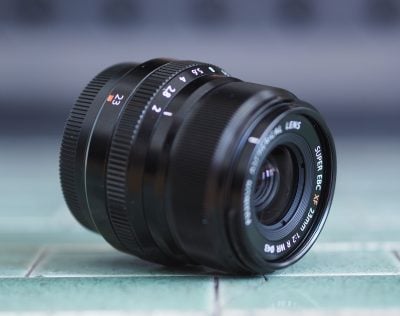Fujifilm XF 23mm f2 review
-
-
Written by Gordon Laing
In depth
The Fujifilm XF 23mm f2 is a standard wide angle prime lens designed for Fujifilm’s X-series mirrorless cameras. Announced in September 2016, it’s the second 23mm lens for the X-series, following the earlier XF 23mm f1.4.
Both lenses deliver an equivalent 35mm field-of-view, a classic mild wide angle that’s ideal for general-purpose use and beloved by street photographers. The most obvious difference between them is the focal ratio, f2 on the new model and f1.4 on the old. This means the older XF 23mm is a stop brighter and better-capable of delivering shallow depth-of-field effects, but countering this, the XF 23mm f2 is smaller, lighter and roughly half the price, while also boasting quicker and quieter focusing, not to mention weather-proofing that’s absent on the old model.
The big question for owners of the original XF 23mm, or those choosing between them, is how the optical quality compares, whether there’s really that much difference in depth-of-field, and if there’s any unexpected gotchas in certain conditions. To find out, I pitched the XF 23mm f2 directly against the XF 23mm f1.4 in a wide variety of tests and for good measure also included the XF 10-24mm f4 zoom as many will be considering it too. Read on to find out which wide lens will be best for your X-series body in my full review!
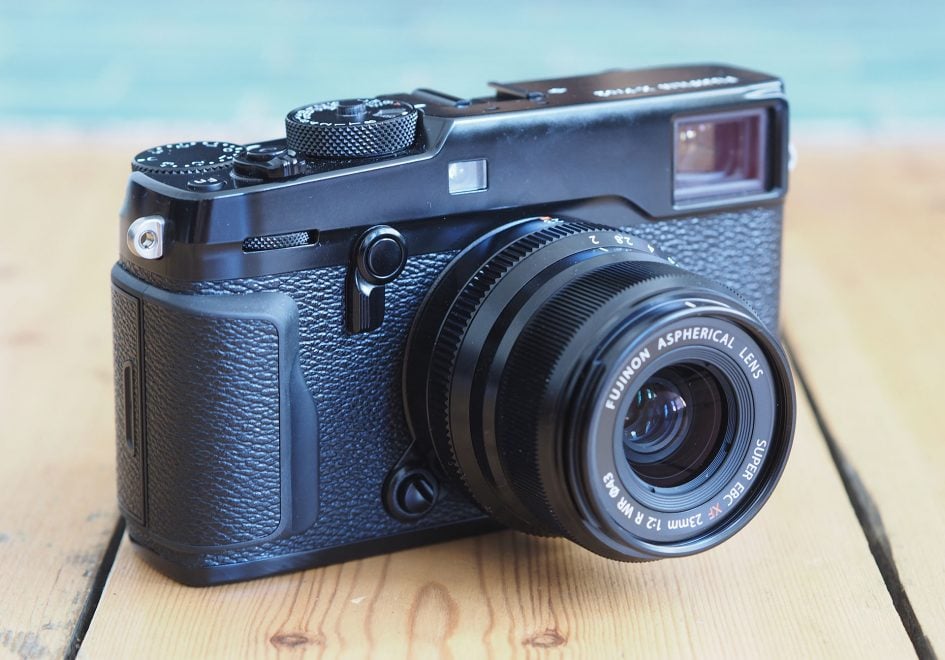
Fujifilm XF 23mm f2 design and build quality
The Fujifilm XF 23mm f2 is the second model in its compact, weather-sealed f2 series, following the XF 35mm f2; it was later joined by the XF 50mm f2. Like those models, it shares a simple, slightly tapered profile designed to present the least obstruction in the corner of the optical viewfinder on the X-Pro bodies – although of course all X-series owners can appreciate the compact and lightweight form factor.
At its widest point around the aperture ring, the XF 23mm f2 has a maximum diameter of 57mm, but again this tapers beyond the aperture ring to 45mm by the time you reach the 43mm filter thread at the end. Meanwhile the lens barrel measures 52mm in length, making it a fairly compact walk-around lens, albeit not quite in the pancake territory of models like the XF 27mm f2.8.
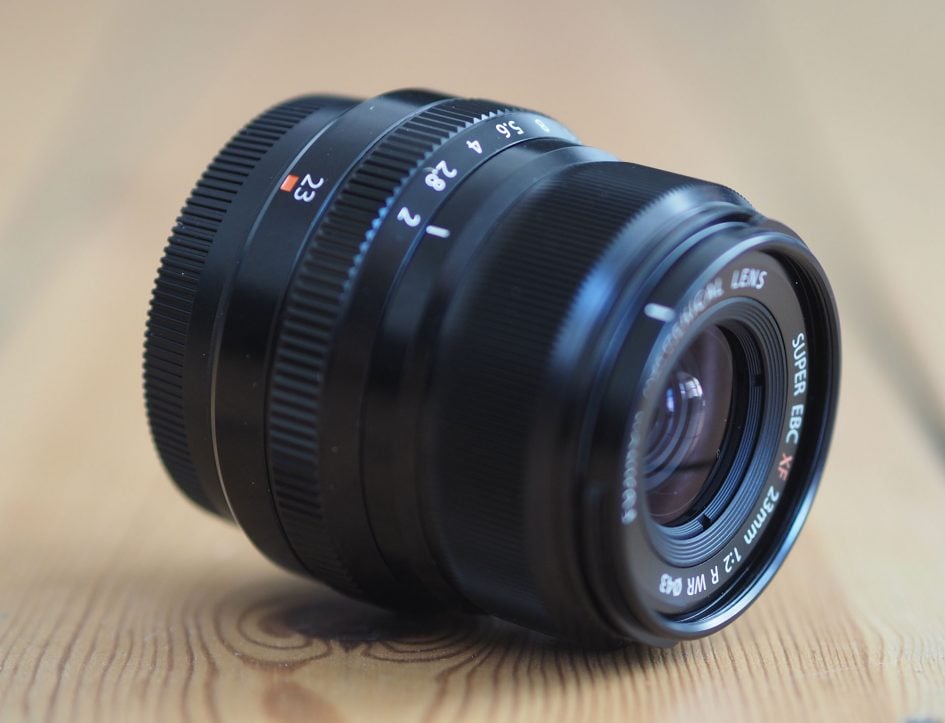
The XF 23mm f2 is the second 23mm lens in the Fujifilm lineup, following the earlier XF 23mm f1.4. The latter is a comfortably chunkier lens, as you’d expect given its larger aperture, measuring 55mm at the lens mount and gradually thickening to 68mm at its widest point around the manual focusing ring. It then tapers a little before the 62mm filter thread. This older, brighter lens is understandably heavier too: 300g compared to 180g for the newer f2 version.
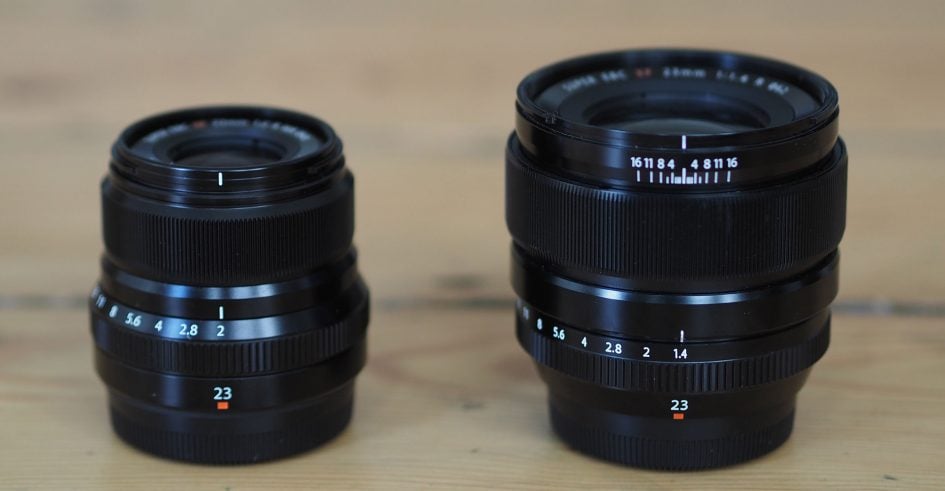
Above left: Fujifilm XF 23mm f2. Above right: Fujifilm XF 23mm f1.4.
In case you’re wondering how both of the 23mm lenses compare to the XF 10-24mm zoom, here’s how they look side-by-side.
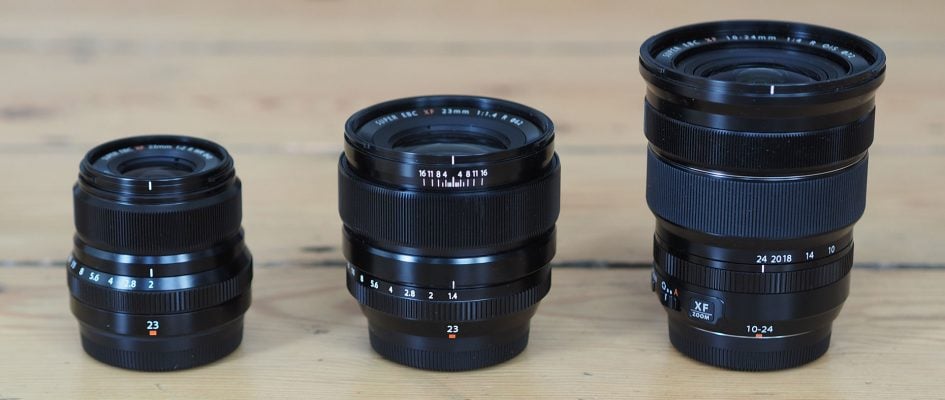
Above left: Fujifilm XF 23mm f2. Above middle: Fujifilm XF 23mm f1.4. Above right: Fujifilm XF 10-24mm f4.
Both of the 23mm lenses are supplied with lens hoods, but their design is significantly different. The newer XF 23mm f2 comes with a very modest circular hood, measuring just 15mm in depth and tapering inwards at the end. Meanwhile the XF 23mm f1.4 comes with a considerably larger petal hood measuring 55mm at its deepest point. Obviously the latter provides much greater protection from flare, but when fitted for use it almost doubles the total length of the lens. It can at least be reversed over the barrel for transportation, and leaves most of the aperture ring accessible should you want to quickly use it in this configuration.
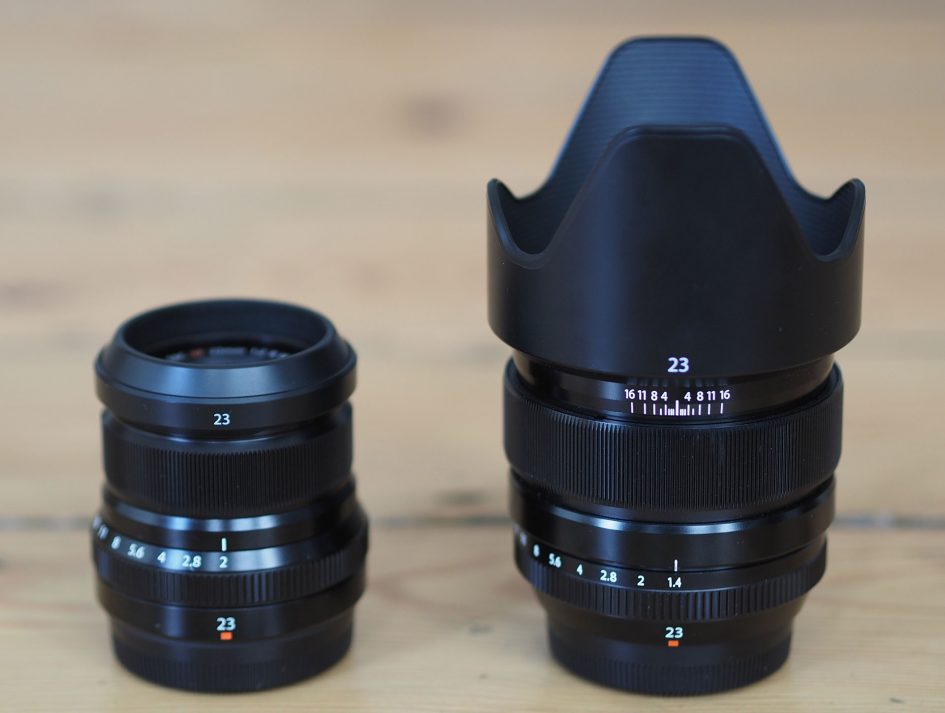
Above left: Fujifilm XF 23mm f2. Above right: Fujifilm XF 23mm f1.4. With lens hoods.
Both have manual focusing rings which, like all Fujifilm X lenses, focus the optics via a fly-by-wire motorized process, but they’re implemented differently. On the newer XF 23mm f2, the manual focusing ring spins freely regardless of the camera’s focusing mode and has no hard stops. In contrast, the XF 23mm f1.4’s focusing ring can be pushed away from the body for autofocus operation (at which point it’s locked from turning), or pulled back towards you for manual focusing (revealing distance markings, a depth-of-field scale and hard stops, although still employing motorized control). While it’s nice to have distance and depth-of-field markings on a lens, I find the digital scale provided on the Fujifilm bodies work fine, especially with the motorized process.
In terms of autofocus the newer XF 23mm f2 focuses a little faster, more smoothly and more quietly than the older XF 23mm f1.4, but there’s not a huge amount in it. Video shooters or those demanding the fastest performance will prefer the newer f2 model, but I never felt held back nor frustrated by the older model.
Both lenses have aperture rings, clicked at third-stop intervals from their maximum focal ratios of f2 and f1.4 respectively, to their minimum of f16, followed by an A position for Program or Shutter Priority.
In your hands, the two lenses feel similar in terms of build quality and the smoothness of the aperture and focusing rings. Again like the other recent f2 models though, the XF 23mm f2 enjoys the benefit of weather-sealing with a rubber grommet around the lens mount – and presumably greater sealing around the barrel itself, although Fujifilm doesn’t go into details. Either way, the rubber grommet is a clear difference with the XF 23mm f1.4 which lacks any kind of official sealing. I was always disappointed by its absence on early Fujifilm lenses, and while I’m pleased to find all the new models enjoy sealing, I remain frustrated the older ones did not. That said, I’ve used the XF 23mm f1.4 in a variety of conditions without issue.
Fujifilm XF 23mm f2 optical construction
In terms of optical construction, the Fujifilm XF 23mm f2 employs ten elements in six groups, including two aspherical elements. The maximum focal ratio is f2, the aperture employs nine rounded blades and the closest focusing distance is 22cm for a reproduction of 0.13x. Like all of Fujifilm’s prime lenses to date, the XF 23mm f2 does not offer optical stabilisation, so since none of the bodies at the time of writing offered built-in stabilisation either, you’ll need to be aware of minimum shutter speeds to avoid camera-shake; videographers wanting to iron-out any wobbles will need to use third party stabilising rigs.
The closest lens in Fuji’s catalogue, at least in terms of focal length, is the older XF 23mm f1.4. This employs 11 elements in eight groups including one aspherical element, sports a maximum focal ratio of f1.4, uses seven aperture blades, and has a closest focusing distance of 28cm for a maximum reproduction of 0.1x. Again there’s no optical stabilisation.
It’s also worth mentioning Fujifilm’s X100 series which feature built-in 23mm f2 lenses. While the focal length and focal ratio match the XF 23mm f2 though, don’t assume they’re the same optical design – the X100’s all-in-one design allows some of the optical elements to be housed within the body and closer to the sensor. Indeed it also implements a simpler optical construction with eight elements in six groups with one aspherical element. That said, while the optical construction is different, I noticed the X100 lens sharing some characteristics with the XF 23mm f2, which I’ll mention later.
But first the coverage. Mount a 23mm lens on an X-Series body and you’ll receive a 35mm equivalent field-of-view, a mild wide-angle that’s ideal for general-purpose, walkaround photography. It’s also a focal length beloved by street photographers. Don’t however assume the XF 23mm f2 and the older XF 23mm f1.4 share exactly the same actual coverage in practice though: shoot the same view with both from a tripod and you’ll discover the XF 23mm f2 is in fact a tad wider than the older model, and when you match the field-of-view with the XF 10-24mm, the EXIF data for the latter reports the focal length as being closer to 22mm. Obviously it’s not a huge difference, but one I wanted to point out none-the-less. You can see the actual coverage of the XF 23mm f2 below left and the XF 23mm f1.4 below right.

Above left: XF 23mm f2. Above right: XF 23mm f1.4. Coverage from same position.

Above left: XF 23mm f2. Above right: XF 23mm f1.4. Coverage from same position.
Here are some more examples of how you might use the lens.

Above left and right: Fujifilm XF 23mm f2.

Above left and right: Fujifilm XF 23mm f2.

Above left and right: Fujifilm XF 23mm f2.
The biggest difference between the XF 23mm f2 and the earlier XF 23mm f1.4 is their focal ratio: one stop brighter on the old model, allowing it to gather twice as much light and deliver shallower depth-of-field effects. To find out what sort of difference in depth-of-field – not to mention rendering of blurred areas – you can expect from each lens, I performed a number of comparisons at their maximum apertures. In each comparison below, the XF 23mm f2 is pictured on the left and the XF 23mm f1.4 on the right.
I’ll start with a portrait composition shot from about a meter and a half away. Here’s the full image from each lens, followed by cropped areas for a closer look.

Above left: XF 23mm f2 at f2. Above right: XF 23mm f1.4 at f1.4. Distance adjusted to match subject size.
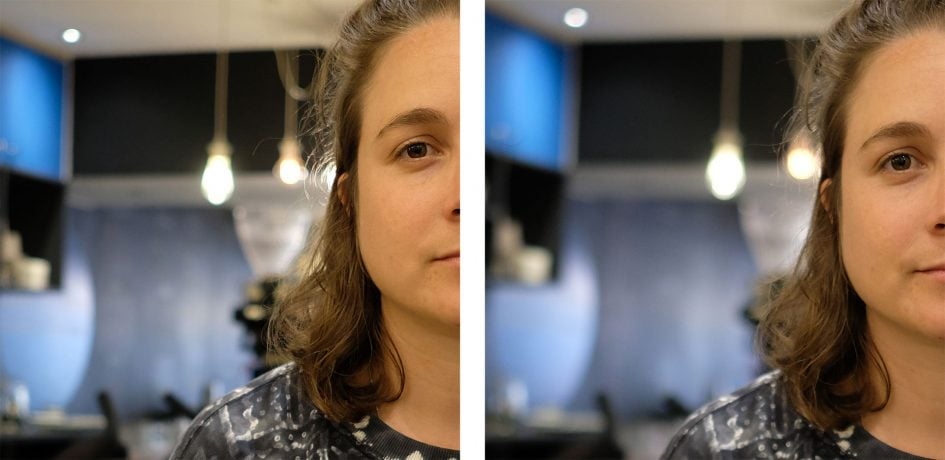
Above left: XF 23mm f2 at f2. Above right: XF 23mm f1.4 at f1.4. Crops from images above.
At first glance there’s not a huge difference in terms of depth-of-field here, given the one stop difference and wide coverage. But look again and the older XF 23mm f1.4 is definitely more blurred in the background, providing greater subject separation and more of a three dimensional effect. Looking at the cropped areas also reveals that while there’s not much difference in bokeh-balls here, there is in terms of the rendering style. Not only is the depth-of-field shallower on the older 23mm f1.4, but the details are blurred more smoothly. It’s all down to personal preference of course, but the XF 23mm f1.4 definitely has creamier bokeh and it’s not just down to the brighter aperture.
Shallow depth-of-field effects are accentuated at close range so for my next test I shot beer bottles (at Brighton’s Bison Beer shop), close to the minimum focusing distance of the older XF 23mm f1.4; I then roughly matched the subject size with the newer XF 23mm f2 and again shot with both lenses at their maximum apertures.

Above left: XF 23mm f2 at f2. Above right: XF 23mm f1.4 at f1.4. Distance adjusted to match subject size.
With a subject at closer range, the difference in depth-of-field and rendering effects becomes more apparent. The new XF 23mm f2 is certainly capable of isolating the main subject against a blurred background, but the XF 23mm f1.4 delivers a shallower depth-of-field and smoother rendering too. Indeed as I performed these comparisons I came to appreciate the style of the 23mm f1.4 more than I had before – it’s not that the newer XF 23mm f2 is bad – on the contrary it’s very good – but the older XF 23mm f1.4 just has a more attractive approach to rendering in my view.
Shooting subjects at fairly close range also revealed the older XF 23mm f1.4 to be sharper than its newer sibling. The text on the beer bottle in the example above is noticeably crisper on the XF 23mm f1.4 version than the XF 23mm f2 version – see below.

Above left: XF 23mm f2 at f2. Above right: XF 23mm f1.4 at f1.4. 100% crops from images above.
Indeed as you approach the closest focusing distance of the XF 23mm f2 it becomes softer, just like the lens on the X100 series – despite having different optical designs, they share this characteristic, making them less attractive to product and food photographers than other options in the range.
Moving onto bokeh blobs, I photographed a small ornamental tree next, with some LED fairy lights in the background; note the LEDs are lozenge shaped, so aren’t indicative of how the lenses handle point sources of light. I shot with the XF 23mm f1.4 first, close to its minimum focusing distance, then matched the subject size with the newer XF 23mm f2; as with the earlier comparisons, the newer XF 23mm f2 is pictured on the left and the older XF 23mm f1.4 on the right.
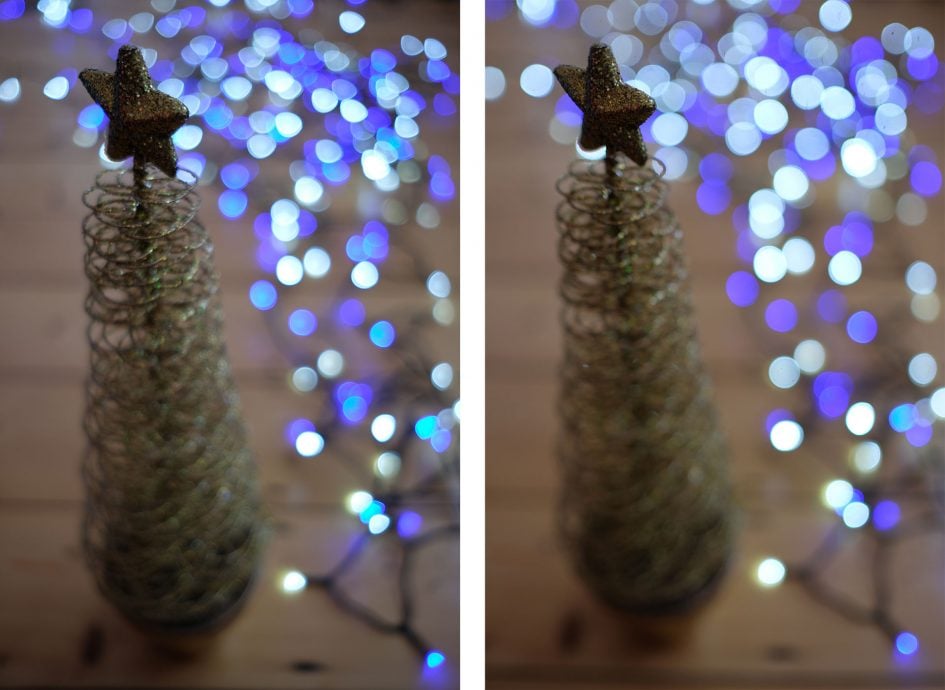
Above left: XF 23mm f2 at f2. Above right: XF 23mm f1.4 at f1.4. Distance adjusted to match subject size.
In the example above, both lenses render the out-of-focus LED lamps quite differently: the newer XF 23mm f2 on the left renders an asymmetrical cat’s eye shape that’s quite distinctive towards the corners, whereas the older XF 23mm f1.4 maintains a more rounded shape. The bokeh blobs from the XF 23mm f1.4 are unsurprisingly larger than the newer lens and while neither suffers from unattractive onion-ringing effects within the blobs, its’ the newer XF 23mm f2 that’s exhibiting more obvious outlining. There’s no right or wrong in rendering, but to me, the older XF 23mm f1.4 looks more attractive in this comparison, even looking beyond the difference in depth-of-field.
If you’re happy to sacrifice subject sharpness, the newer XF 23mm f2 can at least focus closer than its older sibling: 22cm versus 28cm. Here’s how they look with the same subject, but this time focused as close as each lens allows.
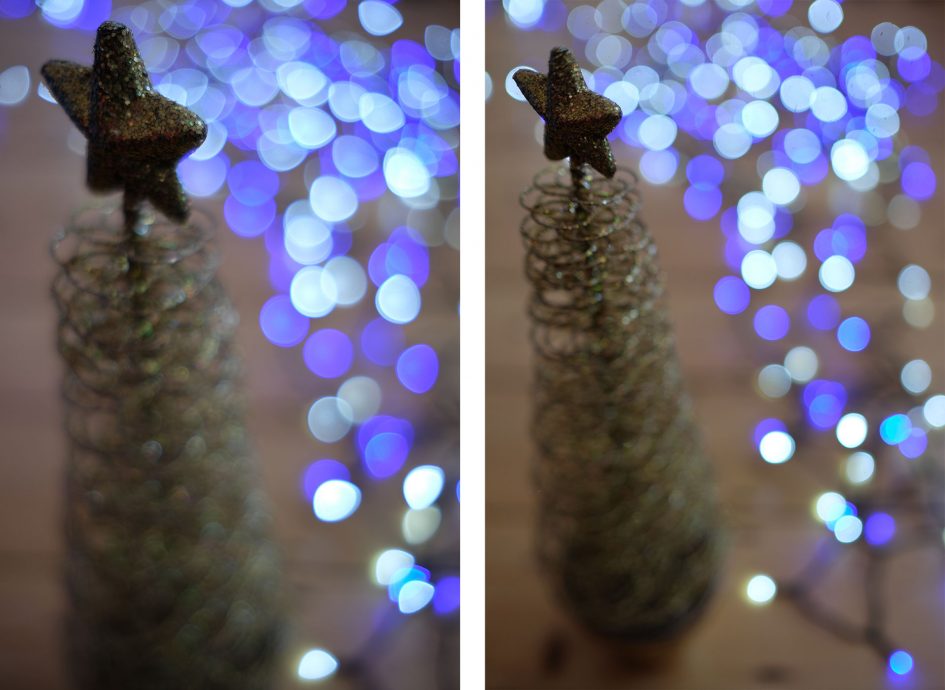
Above left: XF 23mm f2 at f2. Above right: XF 23mm f1.4 at f1.4. At closest focusing distance of each lens.
The closer focusing distance of the XF 23mm f2, above left, has allowed it to more than make up for the slower aperture in terms of bokeh-blob size – now it’s the newer model that’s delivering the larger blobs, despite having a focal ratio one stop slower. The larger blobs have however accentuated the unusual shape of the blobs on the XF 23mm f2 – once again there’s no right or wrong, but the older XF 23mm f1.4 is definitely rendering a more symmetrical rounded shape.

Above left: XF 23mm f2 at f5.6. Above right: XF 23mm f1.4 at f5.6. At closest focusing distance of each lens.
Above is another more literal example showing the impact of their closest focusing distance where I shot a ruler as close as possible with each lens. Above left, the XF 23mm f2 is reproducing a subject width of 140mm across the frame, compared to 206mm for the XF 23mm f1.4 above right. It’s not a huge difference, but the closer focusing distance of the newer XF 23mm f2 will certainly allow you to reproduce smaller subjects larger on the frame. This would at first suggest it’ll be preferable to product and food photographers, but the relatively soft output at close range would have me choosing an alternative option – the newer XF 23mm f2 is happier with subjects at least 1m away, and best of all on the other side of a street.
Moving on, the aperture system does more than just define the potential for blurring. Close it right down to the minimum values and diffraction can render point sources of light into spiked shapes. The number of spikes and their shape is defined by the aperture’s opening and the blades that form its shape. The XF 23mm f2 employs nine blades compared to seven on the XF 23mm f1.4; these in turn mean 18 diffraction spikes on the XF 23mm f2 compared to 14 on the XF 23mm f1.4, but how do they look in practice?
To find out I shot two compositions at dusk which included some bright, distant lights. First a view of The City of London from the South Bank. Here’s the full composition below and below that I’ve cropped and enlarged a portion from just below right of centre which featured the best-defined diffraction spikes. I shot both lenses at their minimum apertures of f16.
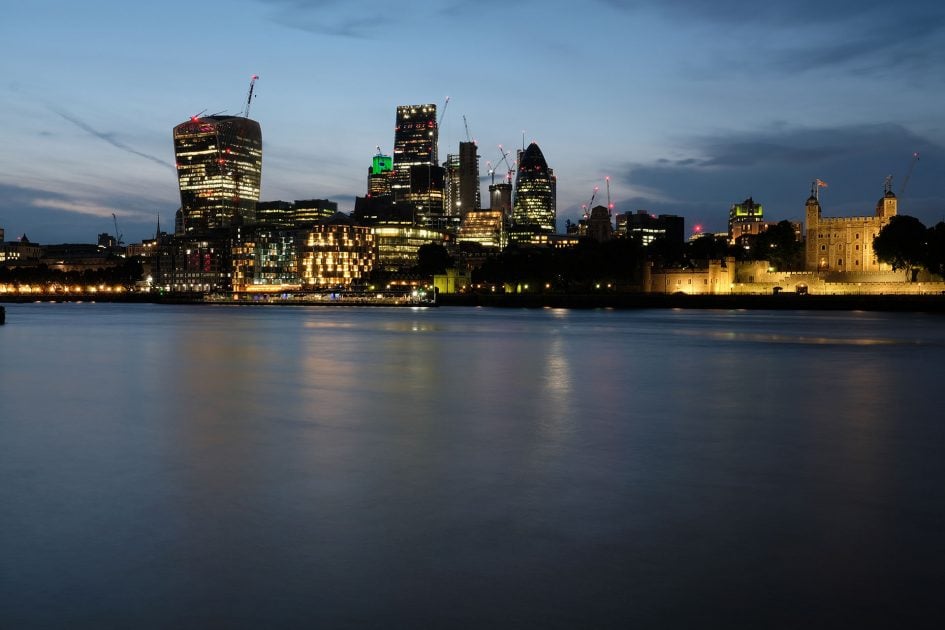
Above: Fujifilm XF 23mm f2 at f16, complete image. Crops below from each lens.

Above left: XF 23mm f2 at f16. Above right: XF 23mm f1.4 at f16. 100% crop from image above.
In the crop above you’re looking at the XF 23mm f2 on the left and the XF 23mm f1.4 on the right; since the shooting distance remained the same, the slightly tighter coverage of the latter lens has delivered a slightly tighter view and crop as a result.
As you can see, the XF 23mm f2 and XF 23mm f1.4 have delivered 18 and 14 spikes respectively as expected from their nine and seven aperture blades. But in the crop above it’s clear how much better-defined the spikes are from the XF 23mm f1.4. This is most likely down to the actual shape of the blades themselves.
For a second example, I photographed London’s Tower Bridge, again with both lenses from the same distance and closed to f16. Here’s the full view, followed again by crops of the best-defined spikes.
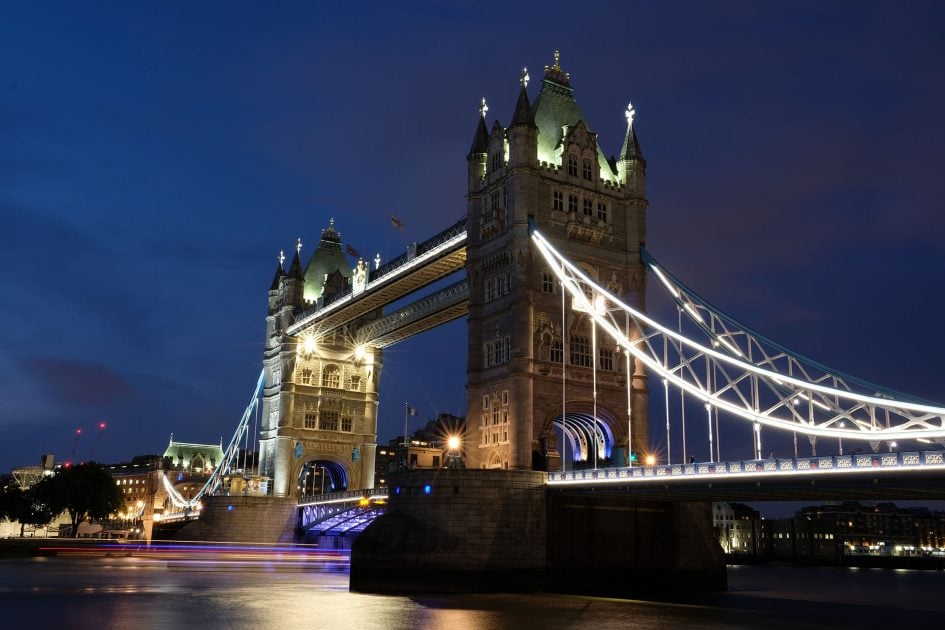
Above: Fujifilm XF 23mm f2 at f16. Complete view. Crops from each lens below.
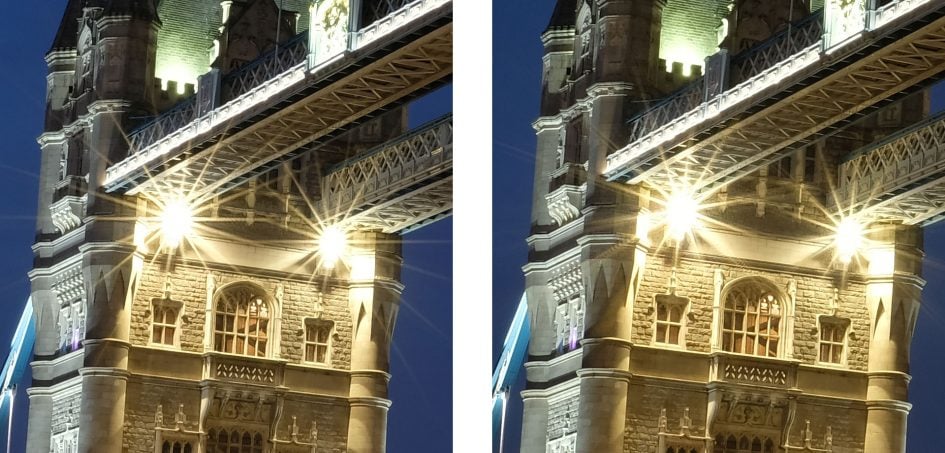
Above left: XF 23mm f2 at f16. Above right: XF 23mm f1.4 at f16. Crops from image above.
With a brighter light at closer range, the XF 23mm f2 above left performs noticeably better than it did in my first example, indeed arguably better than the older XF 23mm f1.4 pictured above right. The diffraction spikes from the newer XF 23mm f2 here are a little sharper and better-defined than the older model, delivering an attractive effect.
Which is the better lens for diffraction spikes? Well judging from these two examples, it depends on the lights in question. The newer XF 23mm f2 delivers great-looking spikes when the light is bright and fairly close, but for more distant dimmer lights, the older XF 23mm f1.4 takes a decisive lead. I should also say that while I slightly preferred the spikes from the newer lens in the Tower Bridge example, the older XF 23mm f1.4 was perfectly respectable in this test.
And finally for my tests on this page a quick look at geometry and vignetting. As before the XF 23mm f2 is on the left and the XF 23mm f1.4 on the right; for the geometry, both were set to f5.6, while for the vignetting, both were set to their maximum apertures and focused to infinity. In this instance I’ve used out-of-camera JPEGs with the default corrections.

Above left: XF 23mm f2. Above right: XF 23mm f1.4. Geometric distortion.

Above left: XF 23mm f2. Above right: XF 23mm f1.4. Vignetting.
Both lenses are pretty well-behaved in both regards, at least for the out-of-camera JPEGs. The only thing to note is a minor difference in geometry, with a small pincushion from the XF 23mm f2 and a small barrel from the XF 23mm f1.4 – certainly nothing to be worried about.
Keep reading for my final verdict or if you’d like to delve deeper, check out my outdoor resolution comparison on the quality page, or my sample images page.
Fujifilm XF 23mm f2 final verdict
Fujifilm’s XF 23mm f2 is mild wide-angle prime lens for Fujifilm’s mirrorless X-series. It’s smaller, lighter and more affordable than the earlier XF 23mm f1.4, while also boasting quicker, quieter and closer focusing, not to mention weather sealing and a narrower tapered barrel that presents less of an obstruction to the optical viewfinder on X-Pro bodies. The XF 23mm f2 exhibits some softness at very close range and or at the largest apertures, so is best-suited to subjects over a meter away, ideally shot around its optimal aperture of f5.6. The older XF 23mm f1.4 delivers a shallower depth-of-field and smoother rendering, and while it won’t focus as close, it remains sharper at all distances and apertures. But if you’re after a good general-purpose lens that’s perfect for street photography, the XF 23mm f2 will serve you well. Its short-comings mean it misses out on my highest rating, but it remains recommended none-the-less.
Check prices on the Fujifilm XF 23mm f2 at Amazon, B&H, Adorama, or Wex. Alternatively get yourself a copy of my In Camera book or treat me to a coffee! Thanks!
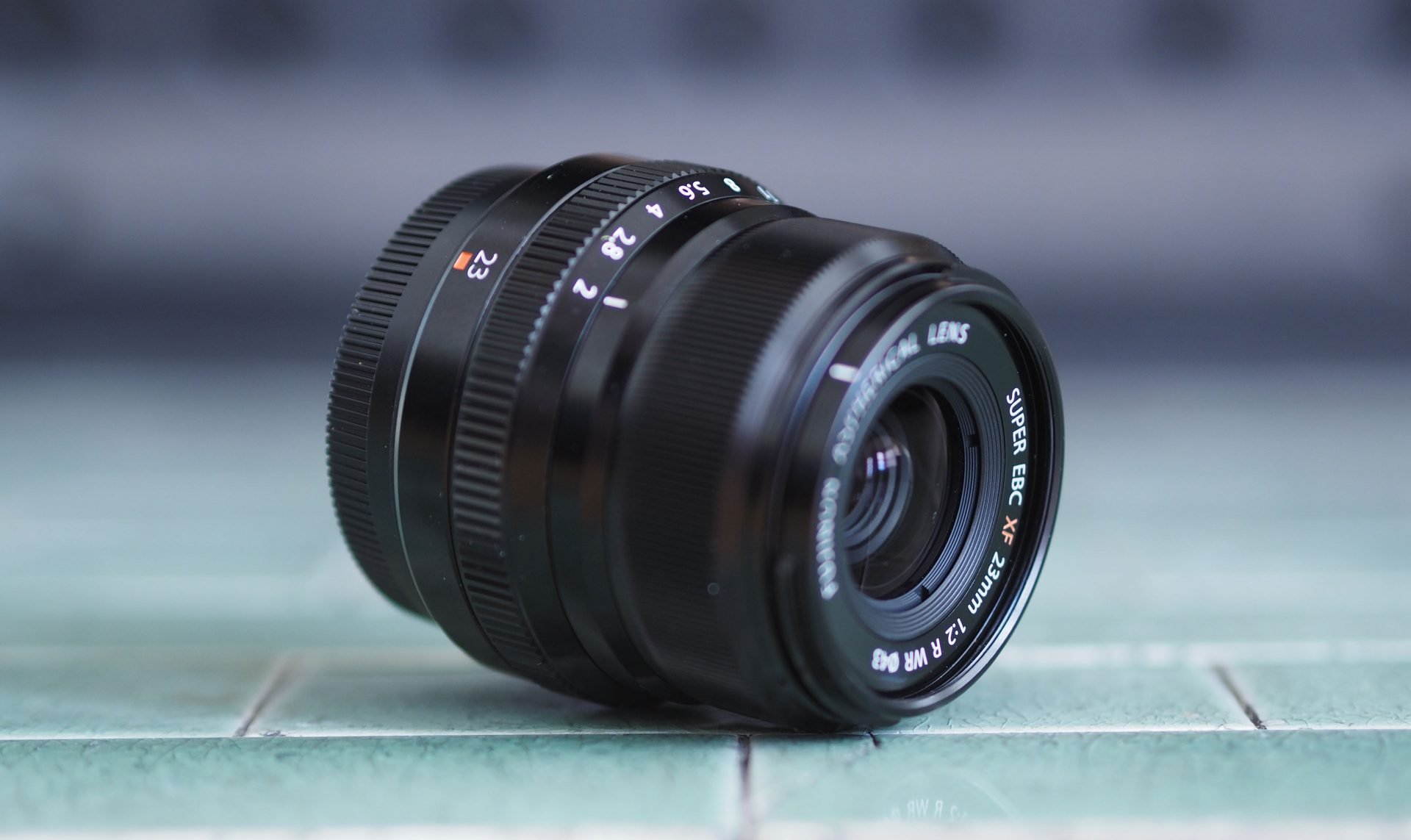
 Fujifilm's XF 23mm f2 is mild wide-angle prime lens for Fujifilm's mirrorless X-series. It's smaller, lighter and more affordable than the earlier XF 23mm f1.4, while also boasting quicker, quieter and closer focusing, not to mention weather sealing and a narrower tapered barrel that presents less of an obstruction to the optical viewfinder on X-Pro bodies. The XF 23mm f2 exhibits some softness at very close range and or at the largest apertures, so is best-suited to subjects over a meter away, ideally shot around its optimal aperture of f5.6. The older XF 23mm f1.4 delivers a shallower depth-of-field and smoother rendering, and while it won't focus as close, it remains sharper at all distances and apertures. But if you're after a good general-purpose lens that's perfect for street photography, the XF 23mm f2 will serve you well. Its short-comings mean it misses out on my highest rating, but it remains recommended none-the-less.
Fujifilm's XF 23mm f2 is mild wide-angle prime lens for Fujifilm's mirrorless X-series. It's smaller, lighter and more affordable than the earlier XF 23mm f1.4, while also boasting quicker, quieter and closer focusing, not to mention weather sealing and a narrower tapered barrel that presents less of an obstruction to the optical viewfinder on X-Pro bodies. The XF 23mm f2 exhibits some softness at very close range and or at the largest apertures, so is best-suited to subjects over a meter away, ideally shot around its optimal aperture of f5.6. The older XF 23mm f1.4 delivers a shallower depth-of-field and smoother rendering, and while it won't focus as close, it remains sharper at all distances and apertures. But if you're after a good general-purpose lens that's perfect for street photography, the XF 23mm f2 will serve you well. Its short-comings mean it misses out on my highest rating, but it remains recommended none-the-less.



